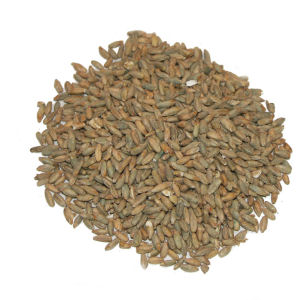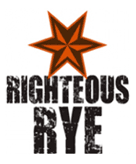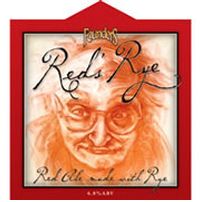Today we’ll take a look at one of my favorite styles. Apart from Cascadian Dark Ales, Rye Beers might be the trendiest style in the craft beer world today, as more and more brewers try their hand at it. Unlike the other styles I’ve looked at, Rye Beers are defined by the inclusion of a particular ingredient instead of the makeup of a recipe; so it’s difficult to peg as a particular “type” of beer. But so many rye beers are so good that we’ll do our best.
Rye Playland

Delicious, delicious rye
As you probably know by now, one of the four ingredients in all beer is malted grain (to answer a friend’s question from the other day, ‘malt’ is a process, not an object — it’s when grain is sprouted by soaking it and then stopped from sprouting with heat.) In the vast majority of beers, the malted grain is barley. However, other grains are sometimes mixed with the barley to add different flavors or textures. That’s where you get wheat beers (hefeweizns and Belgian witbiers), oatmeal stouts, and rye beers.
A kind of Rye Beer called Roggenbier was popular in Medieval Germany. However, the 16th Century saw the inception of the Reinheitsgebot, the famous German purity law (and what bad has ever come from a German purity law?) mandating that beer can only include water, hops and malted barley (yeast was added to the list once science figured out what was going on there). So the Roggenbier died, and is only recently starting to make a minor comeback.
Modern rye beers made in American craft breweries don’t much resemble Roggenbier. Roggenbier is made with majority rye malt, whereas modern rye beers are majority barley cut with rye. (Without going too deep into Beer Chem 101, rye is very difficult to work with.) Thus, most “rye beers” these days can actually be considered as some existing style infused with rye.
Most commonly these beers are basically American Pale Ales or IPAs with rye characteristics. The rye comes across as an earthy, pungent spiciness. It may sound odd, but it mixes wonderfully with American hop varieties. (It should be noted that, with a few exceptions, these beers don’t taste like rye bread, since that distinctive flavor comes from caraway seeds, not the rye itself. I did have a “rye” beer made with caraway seeds at GABF, though. It was…an experience. Quite good, actually.) There are also a handful of rye stouts (Bells in Michigan makes one), rye bocks and some other style variations.
 Rye beers are growing in popularity, and accordingly you can find some nice examples on New York City’s beer store shelves. I’ve already professed my undying love for Bear Republic’s Hop Rod Rye on this site — that one’s on the far ‘IPA’ end of the spectrum. Cane and Ebel from Two Brothers Brewing in Illinois is on the spicier end of the spectrum, as is Righteous Rye from Brooklyn’s Sixpoint, which doesn’t exist in bottles but isn’t uncommon on NYC tap lines. While we’re talking about locals, Blue Point’s Rastafa Rye is terrific as well, on tap or from a bottle.
Rye beers are growing in popularity, and accordingly you can find some nice examples on New York City’s beer store shelves. I’ve already professed my undying love for Bear Republic’s Hop Rod Rye on this site — that one’s on the far ‘IPA’ end of the spectrum. Cane and Ebel from Two Brothers Brewing in Illinois is on the spicier end of the spectrum, as is Righteous Rye from Brooklyn’s Sixpoint, which doesn’t exist in bottles but isn’t uncommon on NYC tap lines. While we’re talking about locals, Blue Point’s Rastafa Rye is terrific as well, on tap or from a bottle.
New York Ale Project’s Favorite Rye Beer: This is the toughest one yet. All the beers I’ve named above are amazing. I almost can’t believe myself that I’m not naming Hop Rod Rye the best rye beer on earth.
 However, after much deliberation, I’m going to have to give the prize to Red’s Rye PA from Founders Brewing in Grand Rapids, MI. As has been mentioned elsewhere on this blog, Founders came to NYC earlier this year. Their beers are fairly common on tap, though almost non-existent in bottle form so far in NYC. But Red’s Rye is quickly becoming a beer bar staple in the City, and with ridiculously good cause. In no other beer do the hop and rye characteristics blend in such perfect harmony. Perfectly balanced and delicious. If you can find it on cask, it’s a revelation.
However, after much deliberation, I’m going to have to give the prize to Red’s Rye PA from Founders Brewing in Grand Rapids, MI. As has been mentioned elsewhere on this blog, Founders came to NYC earlier this year. Their beers are fairly common on tap, though almost non-existent in bottle form so far in NYC. But Red’s Rye is quickly becoming a beer bar staple in the City, and with ridiculously good cause. In no other beer do the hop and rye characteristics blend in such perfect harmony. Perfectly balanced and delicious. If you can find it on cask, it’s a revelation.
Some Local Rye Beers
- Righteous Rye by Sixpoint Craft Ales (“A-” average on Beer Advocate)
- Rastafa Rye by Blue Point Brewing Co. (“B+” average)
- The Manhattan Project by Brooklyn Brewery (“B+” average”)(No longer exists, but worth mentioning. It was Garrett Oliver’s attempt to make a beer that tastes like a Manhattan, my favorite cocktail. The jury’s split on whether he succeeded, and among those who think he did, the jury’s split again about whether or not that’s a good thing.)
Tags: beer styles, blue point, Founders, rye beer, Sixpoint






